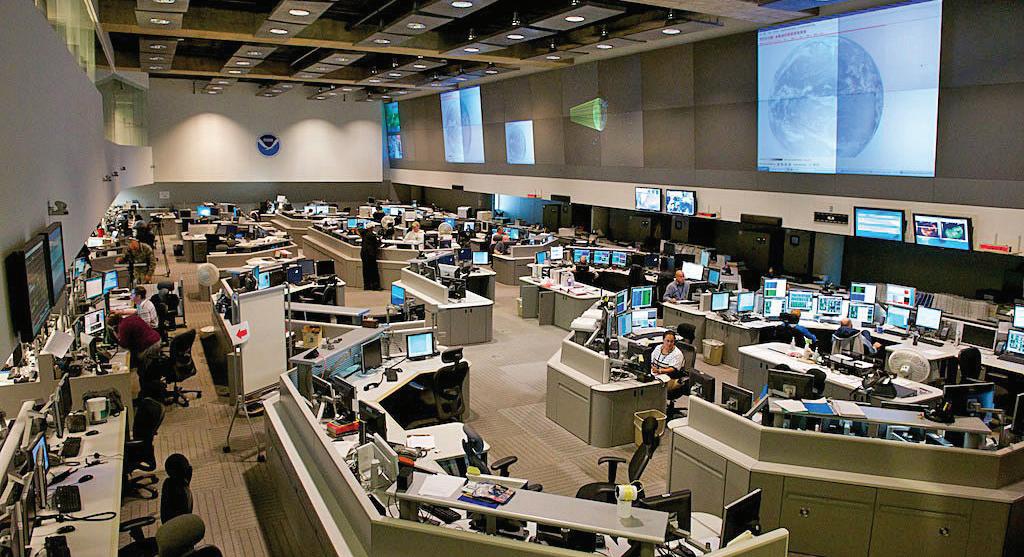
3 minute read
NOAA Satellites Saving Lives
By Craig Collins
NOAA satellites are, famously, weather satellites – but they also play a critical role in search and rescue operations throughout the world. NOAA’s geostationary (GOES) and polar orbiting satellites, along with satellites in the Global Positioning System (GPS), are integral components of NOAA’s Search and Rescue Satellite-Aided Tracking (SARSAT) system. These satellites are on constant alert for radiobeacon distress signals sent by aviators, mariners, and users on land.

Civilian satellite operators work in the National Oceanic and Atmospheric Administration’s satellite operations facility Sept. 25, 2014, in Suitland, Maryland.
When a NOAA satellite detects and gets a fix on a distress signal in the United States, it’s relayed to NOAA’s Satellite Operations Facility in Suitland, Maryland, where it’s then relayed to rescue coordination centers operated either by the U.S. Air Force or the Coast Guard. NOAA also supports rescues worldwide by relaying distress signals to international SARSAT partners. Since this international network began in 1982, Cospas-Sarsat has supported more than 48,000 rescues, including more than 9,000 in the United States.
NOAA’s Sarsat helped rescue 421 people in the U.S. in 2019 alone – a new record in lives saved.
Storms, Floods and Fire
The remote sensing capabilities of NOAA satellites contribute to saving lives in other ways. From orbit, they provide better data for weather prediction and also enable timely and targeted preparation, planning, response, and recovery – before, during and after severe weather events. Its newest geostationary satellites, GOES East and West, scan five times faster and have four times the image resolution, and triple the number of channels, of their predecessors, enabling better storm tracking and smoke detection. Forecasts from NOAA’s National Hurricane Center are supported by imagery from GOES East, which also enables better research and emergency response.

NOAA satellite data also inform the agency’s increasingly accurate flood predictions. During record spring floods over the northern Great Plains in 2019, for example, this data, along with NOAA’s decision support tools, helped local officials make lifeand property-saving decisions well in advance of the floods. Officials in Grand Forks, North Dakota, one of the hardest-hit communities, were able to close levees and begin essential flood-fighting efforts a full two weeks before flooding began.

The Kincade fire seen from space.
In recent years, the ability of NOAA satellites to detect and track smoke with greater accuracy than ever before has been key to firefighting efforts throughout the nation; when Northern California’s Kincade Fire threatened the towns of Healdsburg and Windsor in October and November of 2019, sophisticated sensors on NOAA satellites provided fine detail on fire intensity that helped support firefighters and the Federal Emergency Management Agency to more quickly respond and contain the fire in a heroic all-night firefight that prevented extensive damage to Windsor. Satellites were no less important during the 2018 fire season, when huge wildfires burned in both Northern (the Camp Fire) and Southern (the Woolsey Fire) California. Emergency responders, with accurate smoke movement forecasts fed by powerful satellite sensors and weather models, were able to move people away from danger.
NOAA’s GOES satellites often detect fires before they are spotted on the ground, particularly in remote areas. In March 2018, for example, GOES East detected new hotspots in Oklahoma, part of a cluster of wildfires across the Southern plains. High temperatures and drought made these new flare-ups extremely dangerous, prone to intensifying rapidly, and NOAA notified emergency responders in Creek County, Oklahoma, of a new hot spot before they had received any 911 calls. Fire crews were dispatched to the area and found a grass fire approaching the home and farm of a woman with limited mobility. The Creek County emergency manager later noted that if the crew had not arrived when they did, the woman likely would have lost her life in the fire.
While not officially adding to the “lives saved” tally for NOAA satellites, events such as this demonstrate the importance of the agency’s satellites: In helping planners to save property and lives, they make a big difference.










